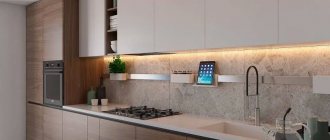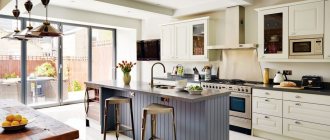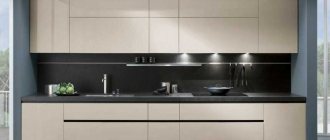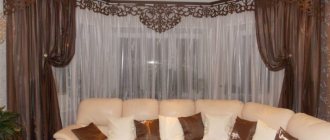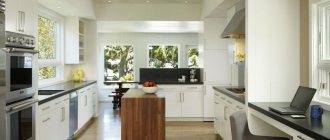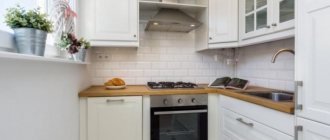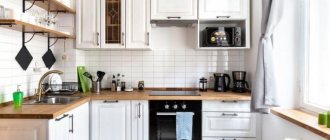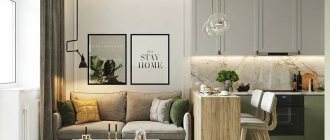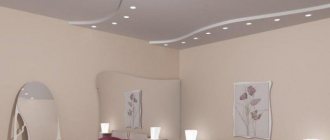The role of a kitchen apron is underestimated:
Due to the small area, it is possible to make an apron a cool accent without spending a lot of money on it.
The 2 most modern options for a backsplash are tiles and glass. But we will analyze the pros and cons of all materials.
I won’t remind you about this anymore, but take into account the size of the kitchen and the resulting density of objects. The smaller the area, the greater the concentration of kitchen utensils, and the fewer details there should be on the apron itself (i.e., without patterns, colors, etc.).
Peculiarities
We are not talking about a housewife's overalls in the kitchen, even if the purpose is almost the same.
An apron is a covering over the work area that protects walls and furniture from steam, high temperatures, drops of grease and food. To adequately cope with this task, for its construction it is necessary to choose a material with good characteristics that does not deform over time and can also be maintained. Although some designers choose to use trim throughout the entire wall, more often the backsplash stands out from the overall composition and serves as a striking detail using color, texture or pattern. You can buy the same finish as the countertop to harmonize the space.
Dark surfaces are considered less practical. But if the backsplash is a rich color, the rest of the room should be "muted." Horizontal stripes will help visually stretch the room, and mirror finish will add volume. Colorists recommend using warm shades, as food looks more appetizing against the background.
But these recommendations are very conditional; you need to go beyond your design skills and tastes, since the range of materials is quite wide.
Other non-standard ideas
You don’t have to limit yourself to the examples described, and you can add some flair to the design, even if you make a design that is less traditional.
The area between the cabinets and the worktop will be filled with:
- Wine corks (they should be cut lengthwise or crosswise, into circles and laid out in different patterns).
- Beer caps.
- Pebbles.
- Shards of broken dishes.
- Remains of a parquet board.
- Disks.
- Cereal panel.
Typically the material is attached in one of two ways:
- Glued onto a sheet of chipboard, which is moisture resistant, and screwed.
- Place on mortars (this applies to dishes, stones, etc.).
It is best to use clear glass in the food preparation area. The panel will cover the apron from grease and water, but will nevertheless allow you to admire the incredible decorations of the kitchen space. A rather interesting and alternative option are vinyl stickers, which can be bought at any hardware store, hypermarket, or ordered online. Various designs - color or black and white drawings, patterns.
Interestingly, a panel is usually used as a base (for example, a sheet of moisture-resistant chipboard or MDF). It is mounted on the wall, and the decor is attached to the top. You can easily change it as soon as you get tired of it.
Technical features when choosing an apron
When choosing an apron, the size of the room is of great importance. The larger the kitchen, the less equipment there will be on the countertop, and on the apron you can choose any ornaments and small motifs. If the area is small, be prepared for the entire table to be filled, and the apron itself to be covered with railings and objects on it. As a result, he will have minimal or no designs.
Apron size range
The height of the apron varies from 50 to 65 cm; determine this parameter yourself, starting with what will be most convenient. Everyone's height is different, and height preferences also vary. If the hood is domed and not built-in, the trim must be extended by another 20-30 cm.
This is an important point if you want to order tempered glass, which will cost more. Or, if you prefer, cover the piece with another material before pulling it out and attaching it nicely to the glass.
The apron must run along the entire perimeter of the kitchen unit, and not just behind the hob and sink. First of all, it's cuter. And secondly, in these places there is always a danger of getting dirty or dirty with splashes of grease. And if there is no material that is easy to clean, all the beauty of the kitchen will fade in a year at best. If the sink is in a corner, extend the apron to the adjacent wall; this area is always the dirtiest.
Dimensions
To determine the size, you should take into account the dimensions of the headset. As a rule, the entire wall between the upper and lower tier of the kitchen is closed. If there is a corner sink, it would be wise to protect it on both sides (and the wall too) so that water does not get on the coating.
As for the width, the apron is made with a margin; it should “go” a little behind the cabinets. Its height is usually 45–60 cm. But keep in mind that according to regulations, the distance between the gas stove and the hood must be at least 75 cm, so in this place you need to provide a protrusion that covers this space.
For a set that does not have a top row, you can lay out the cladding up to the ceiling.
Materials for an apron in the kitchen
What are they and what to choose:
- Ceramic tiles
- Glass
- Made from the same material as the tabletop: laminated MDF or chipboard (postforming)
- Mosaic
- Plastic
- Photo frames, etc.
Only the first 3 are reasonable modern options. They meet all the requirements of sustainability and practicality, and the number of variations in appearance tends to infinity.
The photo card is of poor quality and leaks on the glass. Plastic looks cheap and bad, you can always find cheap tiles that still look much better than plastic.
Ceramic tile
Let's compare tiles with glass. Tile characteristics:
- Huge selection of sizes, colors and textures.
- Unlike glass, it can have a deep texture, which means it will look much cooler under lighting, which is almost always built into upper cabinets.
- The downside is the seams between the tiles, which is not so important if you know how to choose a tile grout, but still.
Phototile
Full photo printing on the tiles leaks onto the glass apron. If you want a design, you can order any one and place it under glass. If we were talking about large areas, like a bathroom wall, then yes, it might make sense in photo tiles, but not on a kitchen backsplash.
One of the advantages is the ability to make a drawing yourself, so that it is clear that the drawing is yours and unique. With a glass shell this is also possible, but your work with tiles is perceived as more interesting.
Glass aprons
Skinali made of tempered glass is a perfectly smooth and durable material for finishing an apron. Depending on the transparency, there are two options for glass surfaces: matte and glossy. And most importantly, under the glass you can place any image that you find on the Internet with sufficient resolution.
Although my advice is to do color, not a photo or drawing. During use, there will be many objects that will disrupt the composition, and initially you may make the wrong choice.
Such options without drawings are standard for high-tech kitchens.
In terms of practicality, glass competes with tiles:
- Easy installation for the customer: go to one place and order everything turnkey.
- The smooth, non-porous surface is not suitable for dirt. Even if you don't clean for a long time, you can always wash it back to its original condition.
- Unlimited possibilities - any image and photo.
- Forgive the lack of texture variation - a smooth surface is very practical, but a deep texture can look very beautiful (especially in lighting).
The disadvantage of glass on the apron is the price. Skinal averages $30-$60 per linear foot, which is comparable to the price of quality tile. The price is adequate, because in all respects they compete on approximately equal terms.
Stone apron
Stone as a facing material comes in two types: artificial and natural. The second option is used much less frequently, mainly due to the high cost, which does not correspond to the duration. But to ensure maximum environmental friendliness of the cladding, you can buy porcelain stoneware slabs. They are quite strong and durable.
Marble looks very noble, but when exposed to moisture it quickly loses its attractiveness. Rational owners prefer artificial analogues. Acrylic and quartz products do not absorb moisture, do not deform, and are also excellent for decorating countertops of the same shape.
A plaster apron can be considered on par with the previous options if a protective varnish is applied. Designers do not recommend combining different types of stone in one space, especially in modern interiors.
Regardless of the origin of the material, its cost is higher than that of other products, and installation requires the intervention of professionals.
Steel apron
This element will fit perfectly into the interior of a kitchen in the style of hi-tech, loft or minimalism, but if you wish, you can choose a suitable option for classical trends. In general, a steel apron is still considered something exclusive. It gives the room a strict, elegant, even “official” look, which is why metal is often combined with “warm” wood.
Aprons are made from affordable stainless steel and more expensive copper. The texture can be different: glossy, mirrored inside, or matte, forming a soft “glow”. A sheet of metal can cover the entire free area so that it does not form seams and creates a feeling of solidity.
The work area will look even more impressive if special lighting is installed above it - the light from spotlights directed at the steel sheet glows beautifully in the evening.
Kitchen apron made of MDF and chipboard (postforming)
In general, it could be made from acrylic, but this is not economically feasible. But chipboard in terms of price/quality ratio is quite sufficient.
MDF and chipboard for the apron are used for both facades and countertops. Postforming is a wood-based adhesive laminated on all sides with durable plastic. Countertops are made using the same principle. Peculiarities:
- Simple installation without preliminary leveling of the walls.
- Equally easy disassembly if necessary.
- Ease of maintenance.
- The ability to accurately implement suspended ceilings or facades in color and texture.
- Economical both in price and in appearance.
Porcelain stoneware apron
The composition of porcelain stoneware includes two types of clay, quartz sand, silicates and coloring pigments. Each ingredient improves the characteristics of the material and also increases visual capabilities.
Due to the cost and complexity of installation, porcelain tiles are often used to finish the entire wall, but where a particularly durable coating is required, you can limit yourself to just an apron.
This type of coating is good because it can be used to imitate any other material: for example, for engraving the texture of wood, which is less resistant to kitchen conditions, or expensive marble.
Brick apron
Brickwork is incredibly popular not only in the loft, but also in other interiors. At the same time, it is not necessary to use rough brick for finishing - you can create the desired texture using more practical materials that will cope with the role of a kitchen apron.
An elegant solution is a brick-look apron made of ceramic tiles. You can choose a glossy or matte texture, and you can choose a custom color scheme. Artificial stone also has the desired effect, but it is recommended to worry about its preparation in advance.
If there is no need to imitate brickwork, then natural brick is suitable for decorating the work area. It is resistant to extreme temperatures, is quite durable and does not require maintenance. Before purchasing, make sure that the surface is not rough, otherwise it will quickly absorb all kinds of dirt.
Mosaic
This option looks very interesting and relevant, but there is a serious nuance to it. Mosaic involves a huge number of seams. If an ordinary tile has 1 horizontal and 3-5 verticals, then a mosaic has hundreds of seams.
Therefore, using a regular shoot for a mosaic on an apron is a so-so option - it will very quickly lose its appearance. What remains is epoxy-based grout, but it is very expensive, you will need a lot of it, and not all craftsmen know how to work with it. Therefore, you will either have to fork out more money, or it is better to abandon the mosaic idea.
But there is an alternative version of the apron - pseudo-mosaic. This is a tile that externally imitates a mosaic in texture and pattern. Mosaic tiles will be much cheaper, the seam area on it will be ten times smaller, and this is important for a backsplash. If the tiler is experienced and the color of the grout can be accurately matched to the color of the false joints on the pseudomosaic, there will be almost no visual differences.
Mirror apron
Mirrors are the rarest material for a kitchen apron, although they can look luxurious. An option is a mirror with a bevel, but we are talking about a luxurious look; cooking in such a kitchen is problematic - cleaning will take just as much time.
Be careful when choosing mirrors for your work apron, as a reflective surface doubles the clutter on your desks. To avoid this feeling, you must always keep the kitchen perfectly clean and not leave unnecessary items on the surface. Of course, you can forget about roof rails.
If you want glare and light, it is better to use glossy tiles or glass; mirrors are only suitable for a kitchen that is not used for its intended purpose at all.
Oilcloth
Yes, an apron can also be made from oilcloth. One of the cheapest options you can do yourself. All you need to do is take the necessary measurements, choose the oilcloth itself, and then attach it to the wall using a furniture stapler.
This option will protect the walls from dirt and water, but for a gas stove it is better to choose another option - the oilcloth can char.
Choosing which apron is best for a given situation is not easy. Most often, people are guided only by aesthetics, but do not forget about other points:
- balance;
- planned duration of use;
- kitchen style;
- difficulty of repair and replacement;
- cleaning.
Focus on these factors, and your apron will delight you for many years.
Plastic apron
A plastic apron is an inexpensive option for finishing a working wall in the kitchen. The plastic panel has a modern look and is easy to assemble. In photographs it is impossible to distinguish it from glass skin, but in real life it looks downright worse. If you have financial problems, it is best to consider the postforming option.
The most noticeable accent in the interior can be a kitchen apron, which, due to its small area, is not worth spending a lot of money on. The 2 best modern options are glass and tile.
Common mistakes
Everyone makes mistakes. But it’s better to learn from the mistakes of others - and to warn your own in time. We talk about some of the pitfalls that accompany the design of the apron area.
Dark tones combined with grainy texture
It looks incredibly impressive, bold and always relevant. But here’s the problem: any stains are clearly visible on such a surface, and grease and soot literally eat into the top layer of the tile. Get ready to scrub them endlessly - or immediately look towards other shades.
Snow-white seams
Many owners, when laying ceramic tiles on a backsplash, want to highlight the contrast and purchase an ultra-white fugue for grouting. Of course, it immediately makes a pleasant impression and favorably emphasizes all the advantages of the chosen tile. However, over time, even waterproof grout loses its color and the seams acquire an unattractive gray tint. Therefore, it is optimal to immediately make a choice in favor of options that are not clearly contrasting.
Poor quality installation of the protective screen.
It can lead to very sad consequences when condensation from violent boiling gets onto the back side of the glass apron. As a result, the surface will become foggy instead of transparent, and if insects also crawl there, then you will have to forget about any aesthetics altogether.
Lay out the apron before installing the headset
It would seem convenient to first cover the wall with material, and then calmly hang the cabinets on top. However, this “seemingly” in practice turns out to be the fact that the furniture can rest against the tiles. If the set was made to order, this is fraught with a new fit. Therefore, the ideal algorithm is as follows: install the set - lay out the apron. And everything will be wonderful!
Materials for the original apron
So, the main ideas ended with how to design an apron. In addition, there will only be very original options.
Discs and glassware fragments
This is where all the necessary and unnecessary junk comes into play: broken slabs, whole slabs, disks - all this is glued to the base, and tile grout. It looks impressive, because it is simply impossible to find such a second apron.
But here too there is a problem with the seams, which will have to be cleaned frequently. In addition, CDs have a mirror surface, on which all drops and dust particles will be visible.
Slate
A very original method is to make a slate board instead of an apron. All you need to do is go over the required space with slate paint three times. It is easy to care for - avoid using abrasive cleaners and hard sponges.
With the help of drawings on the board, you can change the appearance of the kitchen every day - you definitely won’t get tired of it. It will look especially impressive in a white kitchen.
Pebbles
If you are a fan of pebble beaches, then such a corner can be created in the kitchen. For example, in the form of an apron. But since the surface of the stone is uneven, it will be very difficult to clean it, dust will get between the stones, and as a result, such a panel will quickly lose its original appearance.
Wine corks
Yes, too: they smear wine corks on their aprons. Moreover, they not only collect them themselves, but also buy them from bars and restaurants. To speed up the process, cut them in half to make it easier to stick to the backing.
The laying pattern is the same as for parquet. Only the material of the caps is porous, so washing them will be a big problem. You can resort to a constant assistant - glass, but is it worth building an apron that is already thick? The wine stopper idea is suitable for the dining area, but for the work area in the kitchen.
Laminate or parquet
Laminate is preferable to use on an apron, and even more often it turns out to be cheaper than parquet. It is worth choosing high-class material (32-33) and good locks with moisture protection. You will have to install it yourself, since ready-made laminate panels for the apron are not sold. Sticks to liquid nails.
The apron for parquet is made differently: first, the “matrices” are glued to the support using glue or liquid nails, then everything is painted and also attached to the wall. But the paint may melt or crack on the stove, so this method is not suitable for everyone. You can cover the parquet with glass, but then the apron will turn out to be too thick - this is not suitable for everyone. But it looks very original.
Decorative rock
Suitable for aesthetes and connoisseurs of brutal textures. Natural stone is the most durable, but has a high cost. A more affordable option is artificial agglomerate, as well as colored concrete that imitates shell rock.
In addition, the apron can be laid out from budget gypsum tiles “like stone” or “brick”, but their textured and porous surface must be protected with varnish or glass. You can lay such an apron yourself.
Requirements for apron material
When choosing modules in the catalog of kitchen aprons, you need to pay attention to the characteristics of the selected material. The basis for creating a protective coating on the hob must meet a number of requirements:
The area of the apron, even in large kitchens, rarely exceeds 2 square meters. This way you can buy expensive, cool tiles and give your backsplash a really classy look. It’s stupid to miss this opportunity: choosing more expensive facades or countertops will cost a lot of money, but it’s quite possible to spend money on 2 meters of apron.
Tiles with imitation wood, concrete and marble look beautiful, but only with imitation and texture, and not just with a pattern.
White pork is also still in vogue and is likely here to stay. It looks too elegant in both classic and modern styles. There is no risk of looking bad - white pork is the most common and proven option.
- Strength of the material. Robust design makes the material resistant to mechanical deformation.
- Moisture resistant. The presence of an apron implies frequent cleaning of the work area, which means the upholstery does not have to be afraid of moisture.
- Resistant to high temperatures. Heat from the stove can damage some of the materials used to make backsplashes.
In addition, they pay attention to the appearance, presence of decorations and environmental indicators. The production technology must not use toxic or flammable paints and varnishes.
Glass
This is an absolutely environmentally friendly material, widely used in interiors. To protect the kitchen wall, ordinary glass will not work: only tempered glass will withstand the heat from the stove. The glass apron is not afraid of water, is easy to clean from grease, and does not absorb odors.
Transparent material gives the kitchen lightness, fitting perfectly into minimalism, loft and modern style. Can be colored or transparent. Suitable for small kitchens, as it increases the space thanks to its unobtrusive reflective effect. Indispensable if you need to protect an unusual or aggressive coating.
Disadvantages: inability to drill additional holes.
Color composition for an apron
The color scheme plays an aesthetic role in the interior of the kitchen. A variety of shades can either emphasize or spoil the overall design direction of the room. Therefore, the choice of color is approached from a practical point of view.
Natural shades for an apron
A chocolate, wood or walnut shade of an apron is used to decorate a white kitchen. The combination of dark and calm tones and snow-white furniture has a beneficial effect on a person’s mood and psychological state.
Blue and red colors
Rich colors are used to decorate kitchen aprons in light interior models. Bright colors allow you to highlight one or another area of the kitchen and emphasize the original decor of the set.
White color for apron
All shades of white - cream with a bluish tint, cream with pink notes - are used in contrast with dark colors. Most often, such compositions are used for high-tech and Scandinavian kitchens.
Rules for choosing a shade
How to choose the color of an apron for the kitchen? Experts advise starting from the shade of furniture, walls, floors and ceilings. What color material to choose depends on many factors. In itself, it is already an independent element and should fit harmoniously into the overall look.
Combination with headset
The area near the hood looks attractive when selected and repeats the shade of the façade of the set. The rest is a neutral tone. How to choose the right material depends on the countertop. They can be made of the same material, such as stone, or similar in texture and tone.
Finishing in different styles
Analysis of a specific direction helps you make your choice. Each style has its own characteristics that must be taken into account to understand which apron to choose.
An apron for a classic kitchen should be plain and match the color of the front side of the set. If the furniture is dark in color, the wall decoration becomes light and vice versa. A white kitchen enhances the contrast so all colors appear brighter.
Country music is reminiscent of a farm ranch, so stone, wood or imitation natural materials are chosen. Provencal style, on the contrary, involves the use of light colors and small elements. Mosaic, light tiles, MDF panels or glass are suitable here.
When decorating a room in a modern style, the cladding can be done with rough plaster, sheet metal, brickwork or imitation wood.
Color Tips
When deciding which apron to choose, room designers give their recommendations:
- materials for white are easier to collect. An apron for a white kitchen should be chosen in light colors. This will make the space lively and fun.
- If the room is dark, the decoration should be as light as possible. This technique will transform the room.
- The option of dark tones is considered inappropriate, since all the drops, dust and stains will be clearly visible on it.
- Muted shades of red and chocolate are suitable for a beige kitchen. To prevent the walls from merging with the furniture in one place, use opposite color options.
- Which is better for red, yellow or orange kitchens? Here you should use a calm neutral color on the wall. To create contrast, the wall is made completely white or black. But it is worth considering the features of the general design.
- A green or blue surface initially looks bright, so tiles or other coverings should set it off while maintaining the overall style. Don't forget about the combination of warm and cold shades.
- For a brown set, a light-colored glossy finish or brick style is suitable.
- Almost any option is suitable for a gray kitchen. The main thing is that warm tones should be combined with warm ones, and cold ones with cold ones. The glass cover with photo printing will help to break up the mouse-colored earphone.
- An apron for a black and white kitchen should repeat one of these tones or be bright. The trend is red plastic or discreet brown tiles.
- If you need to highlight the set, the wall should be made in neutral colors. In a room where there is a lack of expression, the wall in the work area should be highlighted with fancy upholstery that contrasts with the furniture.
When choosing a surface finishing material, it is important to adhere to the same style and combination with the work surface. View all kitchens
Selection rules
When deciding which apron to choose, some details are taken into account:
- It should be in harmony with the overall interior, not be faded or unspectacular.
- When choosing a shade, preference is given to moderate tones. Bright things quickly tire your eyes.
- To make the shade brighter, use glossy finishes. The matte finish looks pale.
- A large print in a large room may get lost or seem inconspicuous; in a small room it may be too voluminous.
- To visually expand the space, draw a horizontal line along the perimeter of the wall.
- A glass or mirror kitchen apron will make the room visually larger. But it gets dirty quickly and requires special care.
- When finishing with tiles, you should choose a square-shaped material (the size can be any). Looks more aesthetically pleasing.
- Tiles should be purchased at a premium. This is due to the fact that it is quite fragile; if handled carelessly, cracks and chips may appear on it. Moreover, products from different batches may differ in shade.
- Smooth surfaces are easier to maintain, as dirt accumulates even on the smallest imperfections.
Dye
This inexpensive material gives unlimited possibilities when choosing the color of the apron, because the composition can be tinted in any color. Buy paint that can be washed with household chemicals and wiped down frequently - then the coating will last a long time. Leave some of the paint so that the splashback can be restored if necessary.
The main requirement for a wall intended for painting is a perfectly flat surface.
Installation of a kitchen apron
The decision on how to install the lining depends on the selected material:
- Surfaces such as stone, decorative shawls or mosaic designs require more than just expert help. In this case, leveling and plastering the walls will become a mandatory stage of repair work.
- For panels made of plastic, MDF and some types of tiles, no pre-treatment is required.
In other cases, the amount of preparatory work will depend on the quality of the wall cladding, the presence of structural defects and the presence or absence of a complex pattern on the apron.
The apron above the hob is an extremely important element of the kitchen interior. Decorative coating not only performs a practical function, but also plays an aesthetic role, emphasizing the features of the style.
Other replacement options
Today, different types of coatings are used:
- mosaic, the market offers ceramic, glass, plastic cladding elements, their properties are similar to the previously discussed panels made of the same materials;
- cork covering, in this case the kitchen walls are decorated with bottle caps;
- natural stone is the most preferred option, due to its long service life, moisture resistance, resistance to mechanical damage, high temperatures, and chemicals.
The last option is more expensive, so it is not used as often, despite its excellent characteristics.
